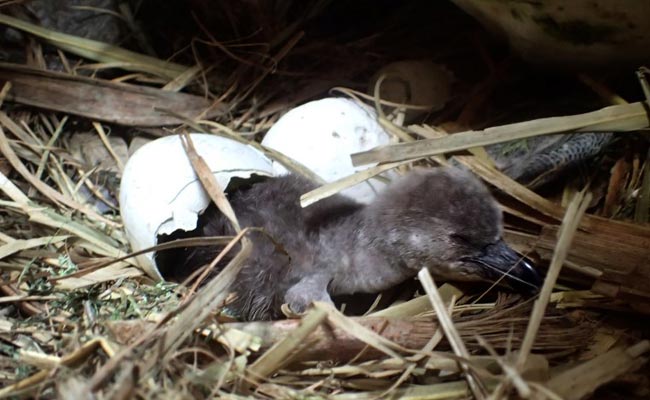
A baby Humboldt penguin which was bred through artificial insemination. (AFP Photo / Shimonoseki Marine Science Museum Kaikyokan)
Tokyo:
A Japanese aquarium said today it had hatched two Humboldt penguin chicks after using artificial insemination, the first time the technique has been successfully deployed for the vulnerable species.
The two chicks were born early April after frozen then thawed sperm from a male penguin was used to inseminate a female penguin at the Shimonoseki Marine Science Museum in Yamaguchi prefecture in western Japan.
"I was speechless when the babies were born safely thanks to the success of the artificial insemination," Teppei Kushimoto, who is in charge of the penguins at the aquarium, told AFP.
The aquarium said it had taken four years of experiments for scientists to figure out how to collect, freeze, and correctly time the artificial insemination for the penguins.
 "We have tried again and again, after numerous failures," Kushimoto added.
"We have tried again and again, after numerous failures," Kushimoto added.
The aquarium said it hoped the development could help safeguard the rare flightless birds, which are designated as "vulnerable" by the International Union for Conservation of Nature (IUCN).
"We believe this will be an effective technique that can contribute to the conservation of the penguins," it said in a statement.
A 'vulnerable' listing on IUCN's Red List means the species faces a heightened risk of extinction in the wild.
The Humboldt penguin, a South American bird which breeds in coastal Peru and Chile, is at risk due to pollution, especially oil spills, over-fishing of the species they eat, and problems with the medium-sized birds becoming entangled in fishing nets.
The Japanese breakthrough comes nearly two years after SeaWorld in San Diego said it had hatched a Magellanic penguin -- which is not an IUCN threatened species -- using artificial insemination with frozen then thawed semen.
The two chicks were born early April after frozen then thawed sperm from a male penguin was used to inseminate a female penguin at the Shimonoseki Marine Science Museum in Yamaguchi prefecture in western Japan.
"I was speechless when the babies were born safely thanks to the success of the artificial insemination," Teppei Kushimoto, who is in charge of the penguins at the aquarium, told AFP.
The aquarium said it had taken four years of experiments for scientists to figure out how to collect, freeze, and correctly time the artificial insemination for the penguins.

The Japanese aquarium said on May 25 it has successfully hatched two Humboldt penguin babies via artificial insemination. (AFP Photo / Shimonoseki Marine Science Museum Kaikyokan)
The aquarium said it hoped the development could help safeguard the rare flightless birds, which are designated as "vulnerable" by the International Union for Conservation of Nature (IUCN).
"We believe this will be an effective technique that can contribute to the conservation of the penguins," it said in a statement.
A 'vulnerable' listing on IUCN's Red List means the species faces a heightened risk of extinction in the wild.
The Humboldt penguin, a South American bird which breeds in coastal Peru and Chile, is at risk due to pollution, especially oil spills, over-fishing of the species they eat, and problems with the medium-sized birds becoming entangled in fishing nets.
The Japanese breakthrough comes nearly two years after SeaWorld in San Diego said it had hatched a Magellanic penguin -- which is not an IUCN threatened species -- using artificial insemination with frozen then thawed semen.
Track Latest News Live on NDTV.com and get news updates from India and around the world

